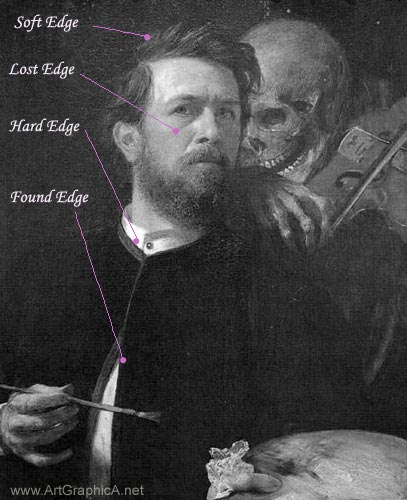Edges appear where one or more shapes conjoin - cloud against sky, clothes against skin, bark against leaves... These edges may be sharp in contrast punctuating that edge and thus drawing the viewer's eye (hard edge), or they may be soft, and more fuzzy like the edges of hair.
They may also be lost and found. A lost edge appears when conjoining shapes of similar value come together - you can usually spot many soft edges in areas of shadow. A found edge is one where the conjoining shapes differ once more in value - i.e. an obvious difference between light and dark is readily shown.
If you squint at a scene from life it is easier to discern these edges than doing the same thing with a photograph, which are flat and evenly sharp.

The following are specific examples picked out of the painting by Arnold Boecklin 'Self-portrait with Death'.
Soft Edge: The ends of the artist's hair are soft.
Lost Edge: The mark beneath the eye fades and loses itself into the raised cheek.
Hard Edge: The white shirt against the black top forms a sharp and very crisp edge.
Found Edge: The jacket joins at the top and is suggested by a subtle lost edge, but is found again towards the lower chest where the shirt is exposed and in the process forms an arrow of sorts that points us towards the area of interest.
Hardening an edge is straight forward: if using a pencil apply more pressure until it stands out, or if using say watercolour, ensure the paper is dry and use less water in your paint mix. Softer edges might be produced with a subtle graduated tones or a blending stump (see fantasy demonstration where the composition begins entirely with softened edges) or working wet-into-wet with watercolour, or using a clean wet brush to soften the edge (see watercolour portrait demonstration).
The difficulty lies in where to place these edges, how to use them to draw the eye to a focal point, and how not to over abuse them, all of which lends a whole new level of creativity to the artist. Experience and experimentation are really the only means in which to further your skills with edges. Always keep the concept in mind when observing the natural world. When you're out and about, try looking at a scene and think, if I were to draw or paint this where are the softest edges and where are the hardest? Try squinting to reassess your opinions.
Tutorial is copyright of ArtGraphica